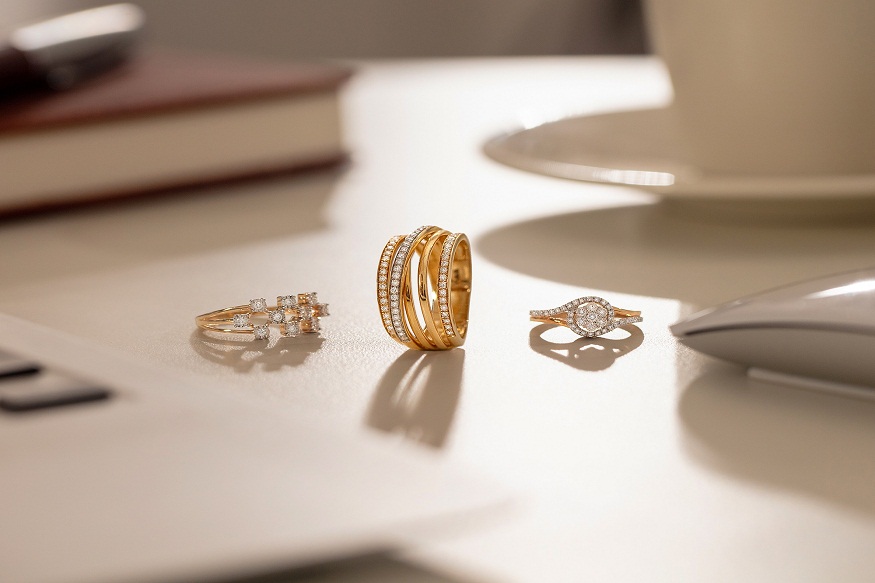 The ageless allure of rings within the jewelry industry has been intensified by technology’s revolutionary potential. Over the last several decades, innovation has totally changed the way rings are made, personalized, and outlined, giving buyers and jewelers access to previously unheard-of conceivable outcomes.
The ageless allure of rings within the jewelry industry has been intensified by technology’s revolutionary potential. Over the last several decades, innovation has totally changed the way rings are made, personalized, and outlined, giving buyers and jewelers access to previously unheard-of conceivable outcomes.
Innovation has essentially affected present day ring design, from 3D printing to computer-aided design (CAD). This has brought about progressively complex, unique, and imaginative plans that express wearers’ particular preferences and personalities.
The Impact of Technology on Modern Ring Design
Technology has revolutionized the design of rings, enabling makers to produce more elaborate and complicated creations than in the past. The following are a few technologies that have affected ring design:
1. The Development of Ring Design: From Craftsmanship to Digital Expertise
Ring design was traditionally a difficult method that greatly depended on the ability and knowledge of experienced jewelers. Hours of painstaking labor were required to form a ring by hand, from drawing the design to carving wax copies, placing stones, and cleaning the finished item.
Although this artisanal strategy yielded excellent results, it was constrained in complexity and customization. Innovation, especially the CAD program, has changed this field significantly since its inception. With the assistance of CAD, designers can now create previously unthinkable levels of flawlessness in their complicated 3D models of rings.
One of the foremost significant benefits of computer-aided design (CAD) is the capacity to see the finished item before it is fabricated. Clients can see a three-dimensional (3D) rendering of their ring from all viewpoints, which encourages modifications and ensures that the finished result matches their vision.
2. 3D Printing: A Revolution in Ring Production
Within the adornments sector, 3D printing has become a game-changer, particularly in the plan and production of rings. With this innovation, numerous customary stages in the jewelry-making process may be omitted, and complicated ring models can be made straight from CAD blueprints.
Designers may experiment with intricate structures, organic shapes, and creative ideas that were previously difficult or impossible to execute thanks to 3D printing. The speed and efficiency that 3D printing provides in ring design is one of its main advantages. After a design is complete, a 3D printer can create a prototype or even the finished object far faster than conventional techniques.
This quick production method has unique advantages. Moreover, many materials can be used with 3D printing, extending from more experimental materials like titanium and carbon fiber to more routine metals like gold and platinum. Jewelers may push the boundaries of what is doable in ring design much appreciated to this flexibility, which makes unused opportunities for creativity and innovation.
3. Laser Engraving: The Ultimate in Personalization
Technology has been instrumental in making customization more widely available, and it has emerged as a significant trend in contemporary ring design. For example, laser engraving lets consumers add personalized details like names, anniversaries, or symbolic messages to rings precisely and intricately.
In contrast to conventional engraving techniques, which could be constrained by the material or design intricacy, laser engraving provides unmatched accuracy and is compatible with various materials. Additionally, laser engraving creates opportunities for more original and creative designs. For instance, it enables the development of patterns or hidden messages only discernible from specific angles or lighting. This heightens the sense of surprise.
4. Augmented and Virtual Reality: Improving the Client Experience
The jewelry business has dramatically improved the client experience by introducing virtual and augmented reality (VR/AR), especially in ring creation. Thanks to VR and AR technologies, customers can virtually try on rings, examine how various designs appear on their fingers, and even modify their rings in real time.
Customers may choose and customize a ring more creatively and with greater engagement thanks to this interactive experience, enabling them to make better judgments. For example, augmented reality apps can use the camera of a customer’s smartphone to superimpose a virtual ring onto the customer’s hand, providing a realistic sample of the ring’s appearance when worn.
This technology benefits online consumers who might have yet to try rings in a physical store. Before making a final selection, it also enables clients to try on several styles, metals, and jewels to make sure the ring they select is ideal for them.
5. Sustainable and Moral Strategies: Technology’s Portion in Upright Ring Design
With buyers becoming more cognizant of ethical and feasible jewelry commerce practices, innovation has ended up a key instrument for ensuring that contemporary ring designs are steady with these standards. For occasion, blockchain innovation is being utilized to track the provenance of resources like valuable metals and precious stones, ensuring that they are sourced ethically.
Customers want assurance that their rings are gorgeous and created ethically; therefore, they place a growing value on this openness. Furthermore, developments in lab-grown diamonds and other synthetic gemstones have developed an environmentally friendly and sustainable substitute for mined stones in ring design.
These artificially grown stones may be created with a lot less impact on the environment and are nearly identical to their natural counterparts. Additionally, technology has made it possible to recycle metals more effectively, which lowers the demand for new mining and supports more environmentally friendly ring design techniques.
6. The Ring Design of the Future: Blending Tradition and Technology
Unquestionably, technology has impacted current ring design, but it’s crucial to understand that technology enhances traditional artistry rather than replacing it. The most exquisite contemporary ring designs frequently fuse the artistry and meticulous attention to detail that stems from centuries of jewelry-making tradition with the accuracy and creativity made possible by technology. In the future, technology should keep spurring creativity in ring design.
Future developments in artificial intelligence, machine learning, and material science could lead to even more inventive and customized designs that accommodate different tastes and lifestyles. It may also become more common for intelligent technology—like NFC chips for secure payments or health monitoring devices—to be included in rings.
Final Thoughts
Technology has dramatically influenced contemporary ring design, changing how rings are made, customized, and worn. Technology has created new avenues for creativity, sustainability, and consumer interaction by fusing the best aspects of tradition with state-of-the-art innovation. This guarantees that rings will always represent love, fidelity, and individual expression in the contemporary world.








Leave a Reply
You must be logged in to post a comment.